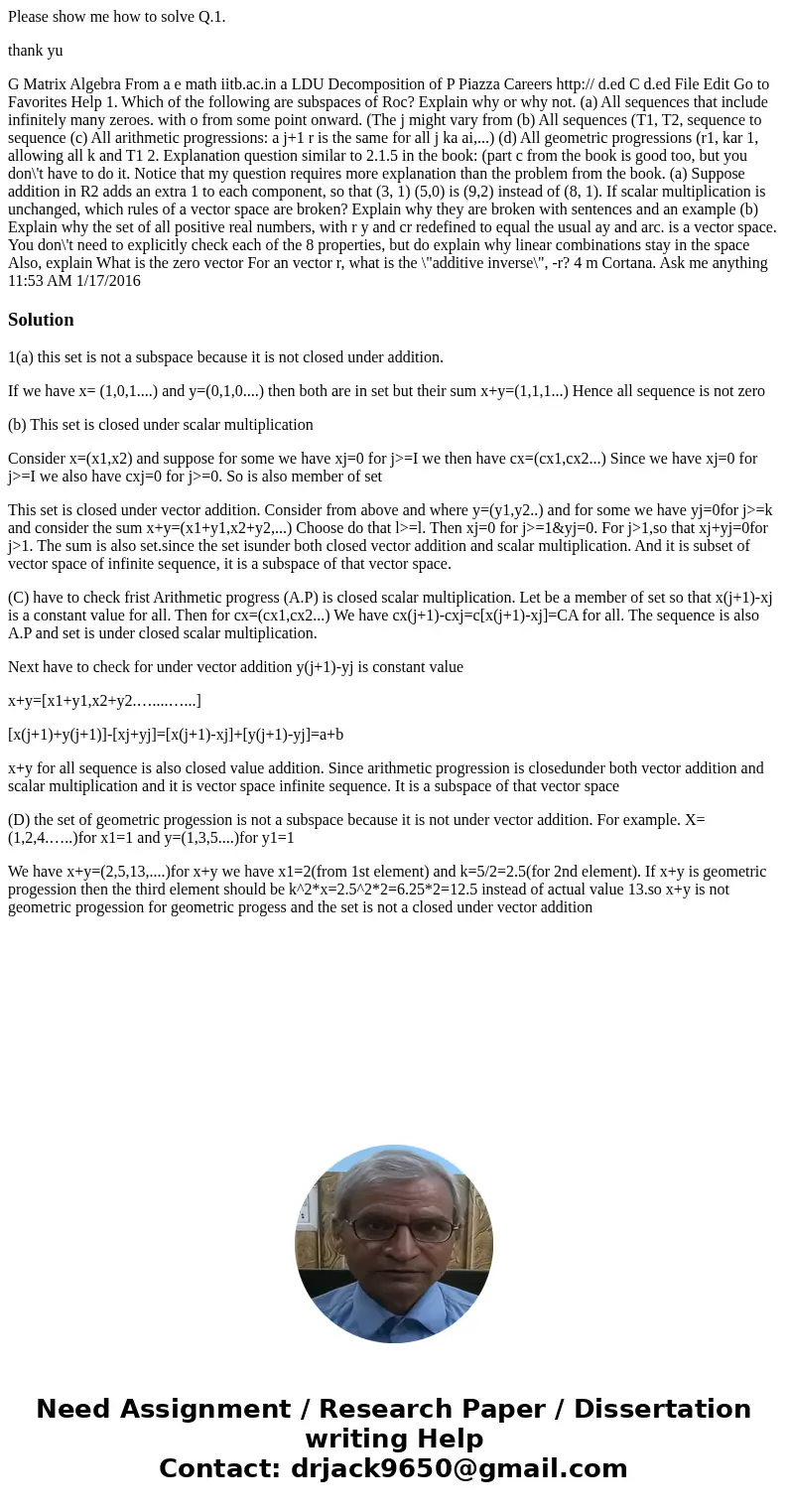Please show me how to solve Q1 thank yu G Matrix Algebra Fro
Please show me how to solve Q.1.
thank yu
G Matrix Algebra From a e math iitb.ac.in a LDU Decomposition of P Piazza Careers http:// d.ed C d.ed File Edit Go to Favorites Help 1. Which of the following are subspaces of Roc? Explain why or why not. (a) All sequences that include infinitely many zeroes. with o from some point onward. (The j might vary from (b) All sequences (T1, T2, sequence to sequence (c) All arithmetic progressions: a j+1 r is the same for all j ka ai,...) (d) All geometric progressions (r1, kar 1, allowing all k and T1 2. Explanation question similar to 2.1.5 in the book: (part c from the book is good too, but you don\'t have to do it. Notice that my question requires more explanation than the problem from the book. (a) Suppose addition in R2 adds an extra 1 to each component, so that (3, 1) (5,0) is (9,2) instead of (8, 1). If scalar multiplication is unchanged, which rules of a vector space are broken? Explain why they are broken with sentences and an example (b) Explain why the set of all positive real numbers, with r y and cr redefined to equal the usual ay and arc. is a vector space. You don\'t need to explicitly check each of the 8 properties, but do explain why linear combinations stay in the space Also, explain What is the zero vector For an vector r, what is the \"additive inverse\", -r? 4 m Cortana. Ask me anything 11:53 AM 1/17/2016Solution
1(a) this set is not a subspace because it is not closed under addition.
If we have x= (1,0,1....) and y=(0,1,0....) then both are in set but their sum x+y=(1,1,1...) Hence all sequence is not zero
(b) This set is closed under scalar multiplication
Consider x=(x1,x2) and suppose for some we have xj=0 for j>=I we then have cx=(cx1,cx2...) Since we have xj=0 for j>=I we also have cxj=0 for j>=0. So is also member of set
This set is closed under vector addition. Consider from above and where y=(y1,y2..) and for some we have yj=0for j>=k and consider the sum x+y=(x1+y1,x2+y2,...) Choose do that l>=l. Then xj=0 for j>=1&yj=0. For j>1,so that xj+yj=0for j>1. The sum is also set.since the set isunder both closed vector addition and scalar multiplication. And it is subset of vector space of infinite sequence, it is a subspace of that vector space.
(C) have to check frist Arithmetic progress (A.P) is closed scalar multiplication. Let be a member of set so that x(j+1)-xj is a constant value for all. Then for cx=(cx1,cx2...) We have cx(j+1)-cxj=c[x(j+1)-xj]=CA for all. The sequence is also A.P and set is under closed scalar multiplication.
Next have to check for under vector addition y(j+1)-yj is constant value
x+y=[x1+y1,x2+y2.…....…...]
[x(j+1)+y(j+1)]-[xj+yj]=[x(j+1)-xj]+[y(j+1)-yj]=a+b
x+y for all sequence is also closed value addition. Since arithmetic progression is closedunder both vector addition and scalar multiplication and it is vector space infinite sequence. It is a subspace of that vector space
(D) the set of geometric progession is not a subspace because it is not under vector addition. For example. X=(1,2,4.…..)for x1=1 and y=(1,3,5....)for y1=1
We have x+y=(2,5,13,....)for x+y we have x1=2(from 1st element) and k=5/2=2.5(for 2nd element). If x+y is geometric progession then the third element should be k^2*x=2.5^2*2=6.25*2=12.5 instead of actual value 13.so x+y is not geometric progession for geometric progess and the set is not a closed under vector addition

 Homework Sourse
Homework Sourse